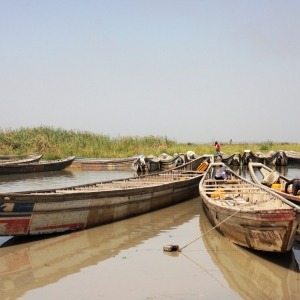Welcome to “What’s Up With Water,” your need-to-know news of the world’s water from Circle of Blue. I’m Eileen Wray-McCann.
In Iraq, an ongoing drought is causing widespread hunger and forcing people to migrate. They’re leaving the countryside for the cities in search of work. That’s according to a report from the Norwegian Refugee Council. The humanitarian group said that half of families in drought-affected regions require food aid and one in five cannot feed everyone in their family. Those numbers were based on surveys of close to 3,000 households across seven provinces in Iraq. Local food systems are buckling under the stress of inadequate water. The surveys found that in the last six months, about a third of grain farmers have lost over 90 percent of their harvest. The failed harvests are a source of other losses, as well. The refugee council said that without a lively farm sector, young men are moving to cities to earn an income. One in fifteen households in the survey had a family member who had migrated for work in the last 30 days. The refugee council warned that unless the rains return, Iraq’s outlook for 2022 remains dire.
In southwest Africa, an ongoing investigation by National Geographic found that a Canadian oil and gas exploration company has consistently violated environmental laws. The company, Reconnaissance Energy Africa, cleared land in Namibia, conducted test drilling, and disposed of water on protected land before receiving proper permits. The drilling site covers an area equal to five football fields. It’s in a conservation zone that borders the Okavango River. Critics have repeatedly warned of the environmental risks of ReconAfrica’s operation. They say that oil drilling in this region threatens the fragile ecosystem in the Okavango Delta and could diminish water supplies that are already scarce.
In the United States, scarce water is also front of mind for officials in the drying Colorado River Basin. At an annual meeting of the basin’s leaders, state and federal agencies announced an initiative to address the shrinking waters of Lake Mead. The country’s largest reservoir is rapidly declining due to heat and insufficient precipitation. Federal government and water agencies in the states of Arizona, California, and Nevada have responded with a $200 million agreement. It aims to conserve an additional 1 million acre-feet of water in Lake Mead over the next two years. That translates into about 12 feet of water in the lake. Half of the funds will come from the water agencies and half from the federal government. A large portion of the water savings will come from paying farmers not to plant crops. The basin’s Native American tribes will be compensated for not taking all the water to which they are entitled. Water districts also plan to reduce withdrawals. Lake Mead reached a record low in 2021. Projections for next year indicate that the lake will drop even lower.
And that’s What’s Up With Water from Circle of Blue, which relies more than ever on your support. Right now, your tax-deductible gift goes twice as far, thanks to NewsMatch – a challenge grant matching your one-time or monthly donation dollar for dollar. It ends December 31 – so find out more – and make a difference at
circleofblue.org. This is Eileen Wray-McCann – thanks for being here for us.





